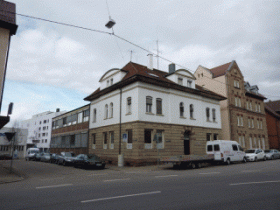Pilot project 5: Thermal treatment
Location
 The pilot test site in Stuttgart-Feuerbach is an example for many inner urban sites that are contaminated with chlorinated solvents.
The pilot test site in Stuttgart-Feuerbach is an example for many inner urban sites that are contaminated with chlorinated solvents.
Problem
Since 1997, different remediation activities (soil vapour extraction and pump and treat) have been implemented without a sustainable remediation effect. Although more than 800 kg CHC have so far been removed, the concentration of CHC in the groundwater has not declined. Preserving the status quo remediation technique would mean:
- Further pumping for decades
- High operating costs
- Restraints on vending or developing the site
A new solution is therefore necessary, but the conditions on the site are challenging. The low permeability and the high heterogeneity of the subsoil, the position of the source zone beneath existing buildings and the tight backyard situation require innovative remediation approaches. In a first ideas competition, three options for remediation were chosen to be reviewed for application on the site:
- Overlapping large boreholes (dig & dump)
- TUBA: In-situ remediation by steam injection and soil vapour extraction
- THERIS (thermally enhanced in-situ remediation): thermally enhanced soil vapour extraction (thermal wells as heat source)
Aim
The most promising method is to apply thermal wells, the so-called 'THERIS method', specially developed for application in low permeable layers. This innovative technology will be applied in the unsaturated and saturated zones by installing thermal wells for conductive heating and the wells for extracting soil vapour. Temperatures of over 100°C can be reached. For quality control, soil heating is monitored and documented. Heating the subsoil causes a rapid transformation of contaminants to vapour phase and improves the permeability of the subsoil. The contaminated air is extracted and cleaned.
Compared to other in-situ remediation technologies, THERIS has the major advantage that low permeability and high soil heterogeneities have only minor effects on heat propagation. The complete volatilisation of contaminants occurs at the boiling point of the water-contaminant mixture below 100°C. Transition of contaminants into gaseous phase is therefore much faster and volatilisation of liquids accelerates the permeability for gases in the subsoil. THERIS is considered a cost-efficient alternative to conventional remediation methods. As a basis, a detailed site evaluation is conducted to describe the lateral and vertical spread of the CHC-contaminated source zone. Based on site-specific risks (including hydro-geological conditions, remediation goals for soil and groundwater and foundation), the source zone treatment area will be defined and the applicability of the methods evaluated.